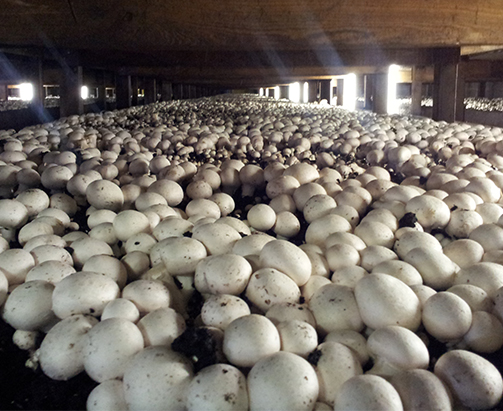How To Grow Mushrooms For Export

Although mushroom farming isn’t as popular as snail farming or fish farming in Nigeria, it does hold its own unique prospects in Nigeria and affords opportunities for export.
Even though Nigeria has a climate that favours the natural growth of mushrooms, most of our mushroom diversities are found in the wild because mushroom cultivation in Nigeria is still in its infancy.
However, with the demand for edible mushrooms growing and for the fact that the initial capital outlay for beginning a commercial mushroom farm is not backbreaking, commercial mushroom farming can be a good source of income for persons who are willing to put in the work.
Alternatively, mushrooms can be grown in small quantities for private consumption.
We will however concentrate on commercial mushroom farming in this article.
Basic facts about mushrooms
Few people know that a mushroom is a type of fungus that typically grows on solid or decaying tree trunks.
Actually, it is the fleshy part of the fruiting body of the fungus. Because it usually grows on decaying tree trunks, mushroom farms are always moist or damp because mushrooms need water to grow.
To successfully cultivate mushrooms, they must be protected from wind and sun. unlike other plants, they do not need sunlight to grow. They are therefore typically grown in shades, but must have access to oxygen which they need for survival.
Finally, and this is a particularly well known-fact, not all mushrooms are good for consumption. This is because quite a handful of mushroom species are poisonous.
Health benefits of mushroom
Asides being a source of good protein and being delicious, edible mushrooms have a lot of health benefits that Nigerians would be wise to take advantage of. Below are a few of the health benefits:
The oyster mushroom has been touted to provide relief to HIV patients. It is currently being studied as a possible cure for the virus.
The button mushroom is used in weight loss programmes and has been proved to help in weight reduction and control.
The shiitake mushroom is said to help in fighting benign/non-cancerous tumors.
Mushrooms are a good source of protein for diabetic patients because they have a low salt content. They are also made up of around 90 per cent water, and are good for a healthy digestive system.
Some mushroom farms actually specailise in the growth of medicinal mushrooms for the prevention and treatment of some illnesses such as cancer, tumour, fibroid, hypertension, wounds and high blood pressure. Its use as antibiotics has also been identified.
Research and applications have shown that mushroom cultivation is relevant to four sectors of the Nigerian economy; food, pharmaceutical, agricultural and the environment.
Beginning a mushroom farm in Nigeria
To begin a mushroom farm, prospective owners need to first familiarise themselves with the categories of mushrooms that exist, and the comparative ease with which they can be grown.
Types of mushroom
There are four categories of mushrooms. They are namely saprotrophic, mycorrhizal, endophytic, and parasitic mushrooms. The easiest of all these to cultivate is the endophytic mushroom. This is because it partners with its host, providing it with nutrients and resistance to pathogens, but can be grown in the absence of such a host.
Of the four, mycorrhizal mushrooms are the hardest to cultivate because of the symbiotic relationship they share with the trees and plants they grow on.
To grow mushrooms on a commercial scale, attention must be paid to the species chosen, taking into note market demand and the environment. In Nigeria, below are the species of mushrooms that are in demand and that are easy to cultivate:
Chanterelles: Chanterelle mushrooms are rich in vitamin C, D and contain a high amount of potassium. It is said to contain more potassium than bananas.
Shiitake: The shiitake mushroom is a variety of mushroom mostly grown in Asian countries, especially in Japan where its name originated from. It has been known to reduce tumors.
Morels: Morel mushrooms protect the liver from toxic materials and contains a high amount of vitamin C and antioxidants.
Oysters: Oyster mushrooms are known to have anti-oxidant and anti-bacterial properties. They also help to reduce the level of cholesterol in the body.
After prospective investors have chosen the species they want to cultivate, then they can go ahead to purchase the spawn.
This is the material that carries the mycelium of the strain of the mushroom, pending when it will be cultivated. It could be sawdust, grain or any substance that can hold the strain of mushroom until it is ready to be cultivated.
Medium of growth
To cultivate mushrooms, the farmer has to decide which medium s/he wants to use. Mushroom can be grown on saw dust or on logs of wood.
Saw dust: The saw dust, which must be free from microorganisms, should be spread into large containers that can provide enough room for proper growth of the mushrooms. Then, the mushroom spawn must be mixed with the medium inside the containers.
As the mushroom spawn needs a certain amount of heat to enable its roots settle in the medium, the containers must be heated with the mushroom spawn and the medium. This is usually done by placing them in direct sunlight for a while.
The heating process must then be followed by putting the containers in a dark room where there is a consistently low temperature. Drawers or cabinets can also suffice in the place of a dark room, for those who are cultivating mushrooms on a lower scale.
Afterwards, the mixture must be left for a period of three to four weeks in the dark room. During that period, the farmer must cover the mixture with soil and continue to spray with water to keep it damp even as the mushrooms grow.
In this case, straw can be used in the place of saw dust.
Logs of wood: Here, the farmer must first make sure that the wood is safe for the growth of mushrooms and is free from any sort of infection.
Then s/he must cut holes into the wood and introduce the mushroom spawn into the holes in the log wood. Thereafter, the logs are kept under a shade, with continuous spraying of water until the mushrooms start to develop. In three or four weeks, as is the case with saw dust medium, the mushrooms will start to grow.
Mushroom spawns can be bought from established mushroom farms. Some even sell fully ramified spawned substrate bags ready for fruiting.
A ready market
There is a ready market for mushrooms, with Nigeria’s hospitality industry being the major consumer of mushrooms.
To cater to the dietary needs of expatriates and discerning Nigerians, many big hotels in Nigeria have mushrooms on their daily menu. But because the local supply does not currently match the demand, they have had to resort to the importation of mushrooms. Therefore, there is a ready steady market for local farmers.
Also, Nigeria is becoming increasingly more health conscious and Nigerians are deliberately avoiding red meat and are substituting it with other sources of protein such as mushrooms.
Edible mushrooms are considered as healthy food because their mineral content is higher than that of meat or fish and most vegetables.
The protein content of fresh mushrooms is about twice that of vegetables and four times that of oranges. To this end, supermarkets and grocery stores are demanding for the supply of mushrooms for onward sales to the populace.
Then there is the international market. There is a huge export opportunity to countries like Serbia and Brazil and some European countries where mushrooms are used for food and in the pharmaceutical industries.
Could be a lucrative business
The best factor in commercial mushroom farming’s favour is the fact that it is a short period product. Cultivation to harvest typically takes four to five weeks, and this makes for one of the shortest investment time frames in the farming industry.
Within a four-cycle period, investment can also be doubled. For example, an investor who begins with an investment of N200,000 is likely to have a net profit of the same N200,000 within 16/20 weeks (a four-cycle period of 4/5 weeks each).
And the risks for loss of investment are very minimal. Mushrooms do not need rain to grow, hence, they are not affected by unusual weather patterns. Also, overheads are extremely low because investors do not have to buy food for the mushrooms. All one needs is the intial investment outlay and nothing more.
And as mentioned above, there is a ready and even growing market for the products. In a nutshell, cost of production is low, and there is a fantastic rate of yield and a high return on investment. It is indeed a lucrative business.
The future of mushroom farming
The demand for mushrooms is on the increase, and is bound to even increase more. Stores, hotels, hospitals, restaurants and individuals will continue to demand for it, and for the farmer who is ready to put in the effort, the reward will be reaped in due time.
For prospective investors looking for funding, the Bank of Industry is currently providing funding for potentially-profitable farm-based businesses. And for those who are unable to access this funding for one reason or another, they can get relations and friends and/or microfinance banks to help.
And because capital outlay can be as low as N40,000/N50,000 depending on size of farm, this shouldn’t be a problem.
Finally, there are established farms such as Jovana providing support, training and materials for new farmers. These farms also typically sell spawns, spraying equipment for mushroom cultivation, pure oyster shell and lime, polythene sheets, treated sawdust, sterilised compost and inoculated mushroom bags for farmers.
So with increasing demand, available funding, and support from established mushroom farms, the future of mushroom farming is very bright.







